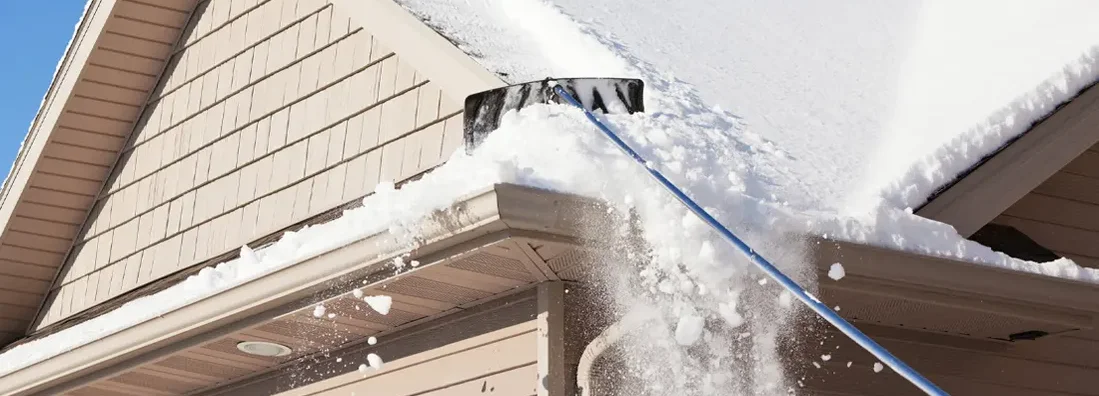Is Too Much Snow on Your Roof an Insurance Problem in South Dakota?

Jeff Green has held a variety of sales and management roles at life insurance companies, Wall street firms, and distribution organizations over his 40-year career. He was previously Finra 7,24,66 registered and held life insurance licenses in multiple states. He is a graduate of Stony Brook University.

Homeowners in South Dakota can deal with an average of 39 inches of snowfall every single winter. But how much snow is too much when it accumulates on your roof? What kind of damage can trapped, melting snow cause, and how does it impact your insurance?
While a South Dakota independent insurance agent can help you find the right type of homeowners insurance to cover ice dam damage and more, we can start by breaking down how to know when snow and ice are a real problem. Good protection for your home against wintry events starts with preparation and ends with insurance coverage. First up, here's a closer look at how much snow is too much on a South Dakota home's roof.
How Do I Know When My South Dakota Roof Has Too Much Snow?
It's not enough to know that too much snow can pose a real danger to your home. Understanding why snow accumulation can be a real threat can help you prepare even further.
Snow accumulation on your roof is a threat because:
- Though light, fluffy snow averages only three pounds per square foot, heavy, packed snow can weigh as much as 21 pounds per square foot.
- Ice can weigh as much as 57 pounds per square foot, posing even more danger to your home's roof.
- All homes are vulnerable to roof collapse past a certain weight threshold, but older homes carry the highest risk of this disaster.
- If the snow and ice on your roof melt before the buildup in your gutters melts, this can lead to the formation of ice dams, which can also pose a serious threat to your home.
Ice dams can lead to water seeping inside your home and even worse issues. That's why it's helpful to keep an eye on your roof after a snowstorm and to know when and how you should remove any precipitation.
Typical Guidelines for Snow Removal
You can certainly hire a professional to remove the snow from your roof, but this can be expensive, and there's no guarantee someone will be available as soon as you need them. It can be risky to leave snow stuck on your roof while you wait for help to arrive. But you can start by following these guidelines to remove snow from your roof yourself:
- Calculate your roof's weight threshold: Most roofs can support up to 20 pounds per square foot before a collapse happens. This can include weight from snow and ice. Make sure to review your specific roof's threshold limit before winter hits so you'll be prepared.
- Understand the weight of the snow on your roof: A simple equation can help you calculate how much the snow and other buildup on your roof likely weighs. Follow weather reports closely, and figure that every 10 inches of fresh snow that has fallen has put about five pounds of weight per square foot on your roof. By this calculation, it can be deduced that most folk's roofs will only be able to support about four feet of fresh snow before there's a real problem.
- Understand the difference in weight of packed snow: Not all snowstorms bring fresh, fluffy snow. Storms that bring wet, packed snow are much more dangerous for your roof, as it only takes two feet of this type of precipitation to exceed your roof's weight threshold limit in most cases. Of course, you'll need to know whether the snow on your roof is fresh or packed, or a combination of both to accurately make your weight calculation.
- Clear your roof ASAP if necessary: Keep in mind that ice accumulation can be very heavy on top of your roof as well. If by your calculations, the weight of snow and ice on your roof is above safe limits, it's time to clear whatever amount exceeds 20 pounds per square foot. A snow rake is a tool that can allow you to do this job yourself, though you can hire a professional to help as well.
- Monitor your roof: Keep an eye on your roof for signs of creaking or popping, sprinkler lines, sunken or sagging tiles, etc., which can all indicate severe stress. Cracks or leaks in your walls indoors can also indicate a stressed roof, as can jammed doors and windows.
Preventing a roof collapse is key to avoiding extensive property damage, both to your home's exterior and your personal contents inside. If you have any concerns about removing snow from your roof yourself, or if you're unsure whether the amount of snow on your roof is safe, don't hesitate to call up a professional to get it removed or inspected.
How Can Ice Dams Damage My South Dakota Home?
When ice dams prevent the normal flow of runoff from melting snow and ice through your gutters, they can stay trapped on your roof and lead to the formation of a pool. Ice dams can really damage your home in several ways by:
- Redirecting runoff water inside the home through little openings around windows and doors
- Resulting in mildew or mold growth inside of the home over time
- Leading to freezing damage of water runoff inside the home
- Ruining electronics, sofas, and other indoor contents
- Causing basement flooding and indoor property damage
- Destroying your roof, shingles, and/or gutters due to the trapped weight
- Leading to roof collapse
Keeping these potential ice dam dangers in mind can help you stay proactive in their prevention and removal when the winter season arrives.
Action Steps to Protect Your Home from Snow and Ice Damage
Though you can't prevent winter weather from occurring, you can often prevent ice dams on your home.
These action steps can help protect your South Dakota home from snow and ice:
- Get a professional home inspection for temperature inconsistencies or leaks long before winter starts.
- Get a professional inspection of your home's insulation.
- Always keep your gutters clear of debris and buildup.
- Seal any leaks in your home around doors and windows well in advance of cold weather.
- Keep your roof clear of snow and other precipitation buildup, especially if you can't determine their weight.
- Call up a South Dakota independent insurance agent to help you find the right homeowners insurance.
Independent insurance agents in South Dakota know exactly which type of coverage can help you recover from ice dams or snow damage to your home. They'll help you find a policy before that first snowstorm ever hits.
Can Homeowners Insurance Help Me after Snow or Ice Damage?
Insurance expert Jeffery Green said damage from an ice dam would be covered except for damage to personal property and other structures. Your home insurance also covers roof collapse, which can be one of the most extreme threats posed by ice dams that sit for too long.
Additional living expenses coverage is also provided by standard home insurance policies. This coverage can reimburse for hotel stays and other unexpected expenses if you can't live at your home while it's undergoing repairs after a major disaster, like a roof collapse. Ask your independent insurance agent for more details about how your home insurance can help you recover from snow and ice damage to your home.
When Doesn't Home Insurance Cover Ice Damage?
Outdoor property destroyed by the weight of ice is not typically covered by homeowners insurance. Water runoff inside the home caused by ice also isn't typically covered, and neither is ice inside your plumbing if you left your home and failed to leave the heat at an appropriate level.
Your South Dakota independent insurance agent can always inform you about situations when ice, snow, and ice dam damage are covered by your home insurance. You can also follow these handy checklists to prevent ice dams and snow damage from ever occurring at your home. Keeping these tips in mind can help you potentially enjoy the winter season this year instead of dreading it.
Why Choose a South Dakota Independent Insurance Agent?
South Dakota independent insurance agents simplify the process by shopping and comparing insurance quotes for you. Not only that, but they’ll cut through the jargon and clarify the fine print so you'll know exactly what you’re getting.
South Dakota independent insurance agents also have access to multiple insurance companies, ultimately finding you the best home insurance coverage, accessibility, and competitive pricing while working for you.
https://icedamremovalguys.com/ice-dam-facts/
https://www.bestplaces.net/climate/state/south-dakota#:~:text=South%20Dakota%2C%20South%20Dakota%20gets,inches%20of%20snow%20per%20year
https://www.usatoday.com/story/news/nation/2015/02/21/kostigen-snow-roof/23671405/
